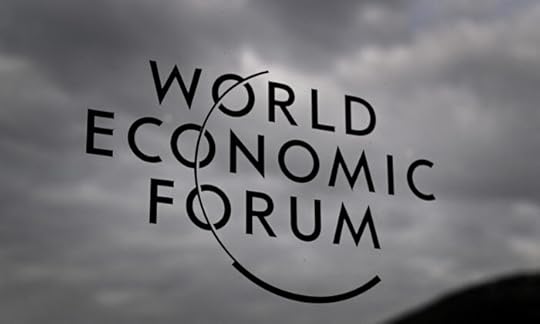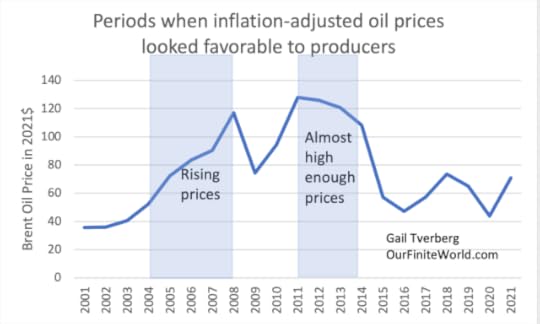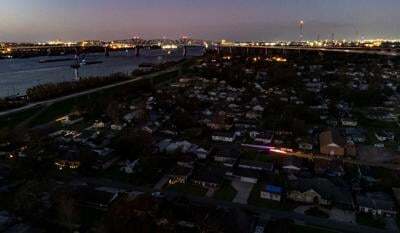Steve Bull's Blog, page 207
July 30, 2022
UN, World Economic Forum Behind Global ‘War on Farmers’: Experts
 A sign of the World Economic Forum (WEF) is seen at the Congress centre during its annual meeting in Davos on May 23, 2022. (Fabrice Coffrini/AFP via Getty Images)US NEWSUN, World Economic Forum Behind Global ‘War on Farmers’: ExpertsThey say ‘Agenda 2030’ development goals at root of sustainability policies that could lead to food shortages
A sign of the World Economic Forum (WEF) is seen at the Congress centre during its annual meeting in Davos on May 23, 2022. (Fabrice Coffrini/AFP via Getty Images)US NEWSUN, World Economic Forum Behind Global ‘War on Farmers’: ExpertsThey say ‘Agenda 2030’ development goals at root of sustainability policies that could lead to food shortagesThe escalating regulatory attack on agricultural producers from Holland and the United States to Sri Lanka and beyond is closely tied to the United Nations’ “Agenda 2030” Sustainable Development Goals and the U.N.’s partners at the World Economic Forum (WEF), numerous experts told The Epoch Times.
Indeed, several of the U.N.’s 17 Sustainable Development Goals (SDGs) are directly implicated in policies that are squeezing farmers, ranchers, and food supplies around the world.
High-level Chinese Communist Party (CCP) members within the U.N. system helped create the SDGs and are currently helping lead the organization’s implementation of the global plan, The Epoch Times has previously documented.
If left unchecked, multiple experts said, the U.N.-backed sustainability policies on agriculture and food production would lead to economic devastation, shortages of critical goods, widespread famine, and a dramatic loss of individual freedoms.
 Klaus Schwab, founder and executive chairman of the World Economic Forum (WEF), is seen at the opening of the WEF Davos Agenda in Cologny, Switzerland, on Jan. 17, 2022. (FABRICE COFFRINI/AFP via Getty Images)
Klaus Schwab, founder and executive chairman of the World Economic Forum (WEF), is seen at the opening of the WEF Davos Agenda in Cologny, Switzerland, on Jan. 17, 2022. (FABRICE COFFRINI/AFP via Getty Images)Already, millions of people worldwide are facing dangerous food shortages, and officials around the world say those are set to get worse as the year goes on.
There is an agenda behind it all, experts told The Epoch Times.
Even private land ownership is in the crosshairs, as global food production and the world economy are transformed to meet the global sustainability goals, U.N. documents reviewed by The Epoch Times show.
…click on the above link to read the rest of the article…
July 29, 2022
The world’s self-organizing economy can be expected to act strangely, as energy supplies deplete
 Figure 1. Chart showing average annual Brent-equivalent oil prices in 2021$ based on data from BP’s 2022 Statistical Review of World Energy, together with bars showing periods when prices seemed to be favorable to producers.
Figure 1. Chart showing average annual Brent-equivalent oil prices in 2021$ based on data from BP’s 2022 Statistical Review of World Energy, together with bars showing periods when prices seemed to be favorable to producers.We are now in a period of price conflict. Oil and other energy prices have remained too low for producers since at least mid-2014. At the same time, depletion of fossil fuels has led to higher costs of extraction. Often, the tax needs of governments of oil exporting countries are higher as well, leading to even higher required prices for producers if they are to continue to produce oil and raise their production. Thus, producers truly require higher prices.
Governments of countries affected by this inflation in price are quite disturbed: Higher prices for energy products mean higher prices for all goods and services. This makes citizens very unhappy because wages do not rise to compensate for this inflation. Prices today are high enough to cause significant inflation (about $107 per barrel for Brent oil (Europe) and $97 for WTI (US)), but still not high enough to satisfy the high-price needs of energy producers.
…click on the above link to read the rest of the article…
July 28, 2022
EU Prepares Public For Winter Gas Siege
European Union policymakers have started to prepare the public for siege conditions this winter if gas supplies from Russia are completely cut, an effort to demonstrate diplomatic resolve as well as avoid panic later in the year.
In recent weeks, officials from Germany and other EU member states have begun to talk openly and urgently about the need for immediate reductions in consumption in advance of the peak winter heating season.
They have also started to plan publicly for compulsory allocation, including rationing and prioritization among industrial users, as well as sharing among member states in the event there is not enough gas to supply everyone.
The stated reason is to accelerate the accumulation of inventories over the remainder of the summer to ensure European countries enter the winter with the highest possible inventories.
In reality, inventories are rising relatively rapidly and are already above the long-term seasonal average in most member states and across the region as a whole.
Inventories across the EU and the United Kingdom (EU28) stood at 751 terawatt-hours (TWh) on July 24 compared with a ten-year seasonal average of 698 TWh.
EU28 stocks were rising at a rate of 5.11 TWh per day in the seven days to July 24 compared with a ten-year seasonal average of 4.61 TWh.
In Germany, the largest stock holder, inventories of 161 TWh were above the long-term average of 145 TWh, and rising at 0.6 TWh per day, compared with a long-term average of 0.72 TWh per day.
On current trends, the European Union as a whole, and Germany in particular, are already likely to enter the winter with above average levels of gas in storage.
The problem is that it will not be enough if pipeline supplies from Russia are cut completely.
EU storage is designed to cope with seasonal swings in consumption not to withstand a war-like strategic blockade.
…click on the above link to read the rest of the article…
July 27, 2022
BASF Prepares To Slash Ammonia Production In Germany Amid Worsening NatGas Crunch
German chemicals company BASF SE paid an extra 800 million euros ($809.5 million) to keep its plants operating in the second quarter compared with a year earlier amid skyrocketing natural gas prices. The impact of high energy prices has forced the company to make a difficult decision: slash the production of ammonia, which could have potential consequences for farming to the food industry.
“We are reducing production at facilities that require large volumes of natural gas, such as ammonia plants,” BASF Chief Executive Martin Brudermuller said in a conference call after an earnings report.
Brudermuller said BASF would tap external suppliers to fill the deficit as German plants reduced output. He warned about potential supply disruptions that could boost fertilizer costs for farmers.
Reuters details how ammonia plays a critical role in manufacturing nitrogen-based fertilizers, plastic-making, and diesel exhaust fluid. A byproduct of ammonia production is high-purity carbon dioxide (CO2) which is heavily used in the food industry.
The news of BASF reducing ammonia production because of soaring NatGas prices comes as Russian state-owned energy producer Gazprom PJSC is expected to halve supplies via Nord Stream 1 to Europe to about 20% today. EU member states agreed Tuesday to reduce NatGas demand by 15% over the next eight months, though countries like Germany, without any liquefied natural gas (LNG) port terminals to replace Russian pipeline NatGas, might have to make more considerable sacrifices.
Benchmark NatGas prices in Europe at the Dutch TTF hub hit their highest level since March. Prices have shot up 35% in a week, over 200 euros per megawatt-hour (MWh), as Putin turns the screws on Europe by reducing pipeline capacity to Europe.
“Chemical companies are the biggest industrial natural-gas users in Germany, and ammonia is the single most gas-intensive product within that industry,” Reuters said.
…click on the above link to read the rest of the article…
We Are Going To See Energy Prices Go Absolutely Nuts This Winter Just As We Plunge Into A Horrifying Global Economic Crisis

How would you feel if your power bill went up by 50 percent this winter? How about 100 percent? Unfortunately, these kinds of price increases are already being announced. The world was heading into a major energy crisis even before the war in Ukraine started, and now that conflict threatens to create an extremely severe energy crunch that would have been unimaginable just a couple of years ago. If some sort of a miracle doesn’t happen, it is going to be a really, really cold winter for countless people in the western world.
The Russians have been trying to use energy as leverage, and on Monday they announced that the amount of natural gas flowing through the Nord Stream 1 pipeline will be reduced “to just 20% of its capacity”…
The Biden administration is working furiously behind the scenes to keep European allies united against Russia as Moscow further cuts its energy supplies to the European Union, prompting panic on both sides of the Atlantic over potentially severe gas shortages heading into winter, US officials say.
On Monday, Russia’s state-owned gas company Gazprom said it would cut flows through the Nord Stream 1 pipeline to Germany in half, to just 20% of its capacity. A US official said the move was retaliation for western sanctions, and that it put the West in “unchartered territory” when it comes to whether Europe will have enough gas to get through the winter.
In essence, Vladimir Putin is “turning the screws”, and it may just be a matter of time before he cuts off the gas completely.
The Europeans never should have allowed themselves to become so dependent on Russian energy, and now a major crisis is staring them in the face.
…click on the above link to read the rest of the article…
Category 4 hurricane? Prepare for 21 days without power, Entergy says
Even a Category 1 hurricane might bring 7 days without power, utility says.
 The electricity has been off for 11 days in Bridge City, La. Thursday, Sept. 9, 2021, in the aftermath of Hurricane Ida. (Staff photo by David Grunfeld, NOLA.com | The Times-Picayune | The New Orleans Advocate)
The electricity has been off for 11 days in Bridge City, La. Thursday, Sept. 9, 2021, in the aftermath of Hurricane Ida. (Staff photo by David Grunfeld, NOLA.com | The Times-Picayune | The New Orleans Advocate)As Louisiana prepares to enter the most active weeks of the hurricane season, an Entergy representative said the public should be prepared to go without power for up to 21 days in the event a Category 4 storm hits the area, and seven days for a Category 1 storm.
The restoration timeline — offered during a presentation Friday to the Kenner City Council — tracks with estimates Entergy provided to local government leaders last August, days before Hurricane Ida walloped southeast Louisiana, roaring ashore near Grand Isle as a Category 4 storm.
At the time, Entergy warned that Ida had the potential to leave residents and businesses in the dark for up to 21 days, if not longer. For most residents in Orleans and Jefferson parishes, the blackout lasted for about 10 days.
Still, the outages left more than a million households and businesses without power in Louisiana’s sweltering summer heat and is seen as a factor in at least a dozen heat-related deaths in New Orleans alone.
[image error] As hurricane season begins, concerns still loom over power after extended outages during IdaAccording to Entergy’s estimates, the public should be prepared to go without power for up to seven days for a Category 1 storm; 10 days for a Category 2 storm; 14 days for a Category 3 storm; 21 days for a Category 4 storm; and more than 21 days for a Category 5 storm.
…click on the above link to read the rest of the article…
Question Everything

The average person in the First World receives more information than he would if he lived in a Second or Third World country. In many countries of the world, the very idea of twenty-four hour television news coverage would be unthinkable, yet many Westerners feel that, without this constant input, they would be woefully uninformed.
Not surprising, then, that the average First Worlder feels that he understands current events better than those elsewhere in the world. But, as in other things, quality and quantity are not the same.
The average news programme features a commentator who provides “the news,” or at least that portion of events that the network deems worthy to be presented. In addition, it is presented from the political slant of the controllers of the network. But we are reassured that the reporting is “balanced,” in a portion of the programme that features a panel of “experts.”
Customarily, the panel consists of the moderator plus two pundits who share his political slant and a pundit who has an opposing slant. All are paid by the network for their contributions. The moderator will ask a question on a current issue, and an argument will ensue for a few minutes. Generally, no real conclusion is reached—neither side accedes to the other. The moderator then moves on to another question.
So, the network has aired the issues of the day, and we have received a balanced view that may inform our own opinions.
Or have we?
Shortcomings
In actual fact, there are significant shortcomings in this type of presentation:
The scope of coverage is extremely narrow. Only select facets of each issue are discussed.Generally, the discussion reveals precious little actual insight and, in fact, only the standard opposing liberal and conservative positions are discussed, implying that the viewer must choose one or the other to adopt as his own opinion.…click on the above link to read the rest of the article…
July 26, 2022
Central Banks, Global Debt & COVID
Ed Dowd summarizes his career and insights as a successful stock picking “conspiracy theorist”.

I first met Ed Dowd during an early trip which a group of physicians from the International Alliance of Physicians and Medical Scientists (www.globalcovidsummit.com) made to the Hawaiian Islands of Maui and Oahu during the fall of 2021. The primary purpose of the trip was to support our physician colleagues Dr. Kirk Milhoan (MD, PhD- Pediatric Cardiologist) and Lorrin Pang (MD, MPH- Maui County Public Health Officer), who were embroiled in an effort by local press and politicians to take their medical licenses for the perceived infraction of supporting early COVID treatment and (in the case of Lorrin) relying on his own evaluation and interpretation of the safety and effectiveness of the COVID-19 genetic vaccines. The particular grievance concerning Lorrin seemed to have revolved around his reservations concerning the lack of data demonstrating safety of SARS-CoV-2 genetic vaccination during pregnancy. After many long months subjected to the usual defamation and derision in local corporate-controlled media, both were eventually exonerated. No final action was taken against them by the Hawaiian medical board, although both were deeply impacted by the experience, and I suspect will forever be more guarded and defensive in their medical practices.
It was during a local group dinner and fundraiser for the cause, held on the island of Maui, that Ed and his colleagues first introduced themselves to me. To my surprise, they indicated that they had authored a document which they named “The Malone Doctrine”. Taken aback, as neither Jill nor I had contributed in any way, I asked why they were using this name. Ed and his colleagues told me that “we have read and listened to everything you have said and written during COVID, and this is what is written in the white spaces between every line”…
…click on the above link to read the rest of the article…
EU Natural Gas Prices Soar As Gazprom Readies Nord Stream Cuts, US NatGas Hits 14-Year High
European natural gas futures extended gains by 12% after Russian state-owned energy producer Gazprom PJSC unexpectedly announced it would halt a Nord Stream 1 turbine at its Portovaya compressor station from Wednesday. Simultaneously, US NatGas futures have spiked to 14-year highs.
Russian NatGas supplies to Europe via Nord Stream pipeline fell to 38% capacity from 40% on Tuesday, ahead of a more significant cut from current levels to just 20% on Wednesday.
In a statement, Gazprom said the Nord Stream pipeline would be pumping 33 million cubic meters a day, or 20% of capacity, from Wednesday, adding another turbine for the pipeline will be taken offline due to maintenance work.
Kremlin spokesman Dmitry Peskov said another Nord Stream turbine has “problems” and will be taken offline for maintenance.
Peskov noted a turbine sent to Canada earlier is “en route” but didn’t specify its exact location.
Western sanctions prolonged the average maintenance time of the Nord Stream.
“The situation is critically aggravated by the restrictions and sanctions imposed against our country,” the Kremlin spokesman continued.
Russian state media reported Monday that the turbine recently serviced in Canada by Siemens Energy AG had finally received export paperwork that will allow it to be shipped from Germany to Helsinki, Finland.
Nord Stream’s upcoming capacity declines sent Wholesale European NatGas futures up 12% to 196 euros. Prices have jumped more than 20% in two sessions and are near highs seen last winter at more than 200 euros.
EU Natgas prices are trading at an oil-barrel-equivalent price of $333….
Across the Atlantic, US NatGas futures extended gains, up more than 10% to $9.62, a 14-year high, amid concerns about hot weather and tight supplies.
…click on the above link to read the rest of the article…
July 24, 2022
Our Entire Civilization Is Structured Around Keeping Us From Realizing We Can Do This

Listen to a reading of this article:
❖
Rise, like lions after slumber
In unvanquishable number!
Shake your chains to earth like dew
Which in sleep had fallen on you:
Ye are many — they are few!
~ Percy Bysshe Shelley
The video footage coming out of Sri Lanka right now has been the recurring nightmare of every ruler throughout history.
Thousands of protesters outraged by the deteriorating material conditions of the nation’s economic meltdown have stormed the presidential palace of Sri Lanka’s President Gotabaya Rajapaksa, and I guarantee you the aerial footage as they poured into the building en masse has made every government leader and plutocrat a little uncomfortable today.
Just look at that. Look at all those people flooding in there. That is some truly awe-inspiring power. Imagine how terrifying it would be to find yourself on the receiving end of it.
I don’t know enough about what’s going on in Sri Lanka yet to comment with any authority on what powers might be at play in this uprising, but I do know that every ruler throughout history has spent time envisioning what would happen if a crowd that size decided to storm their base of operation. If their numbers became too great to suppress, or if your forces who would be doing the suppressing joined the ranks of the people instead, the best-case scenario for you is that you’d have already fled the building by that point, as Rajapaksa had the good sense to do shortly before the building was stormed. If enough angry people get their hands on you, it won’t matter if they’re armed with rockets or pistols or their own bare hands; you are in for a violent end.
…click on the above link to read the rest of the article…











